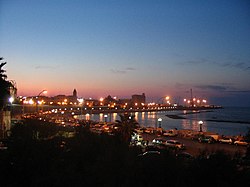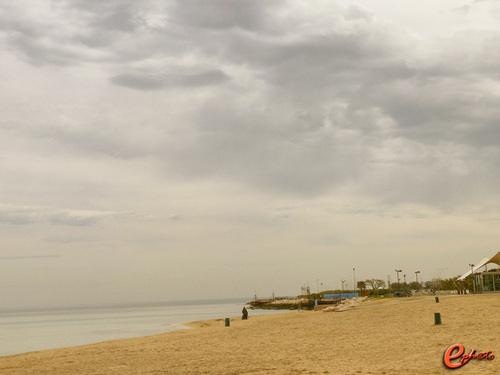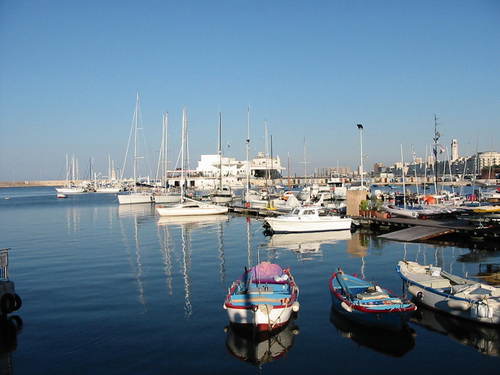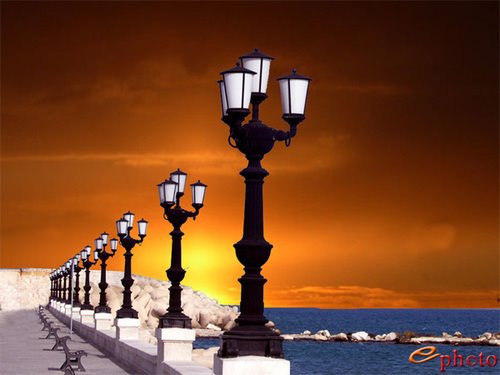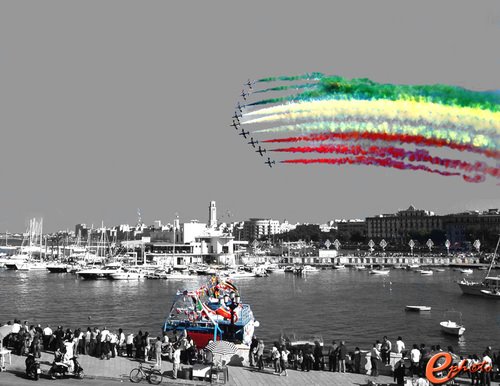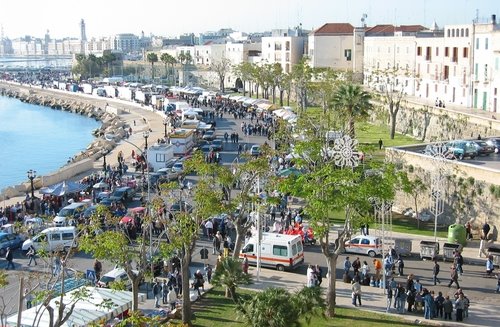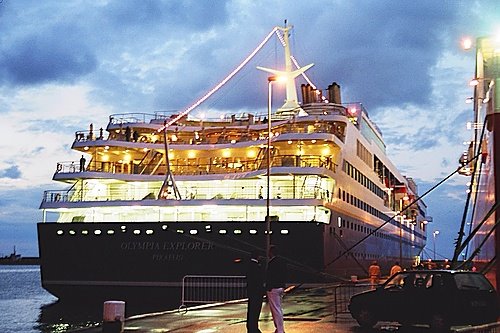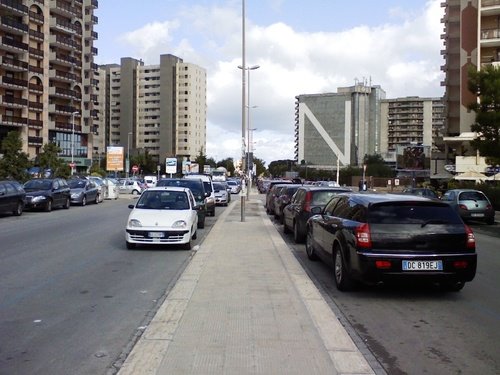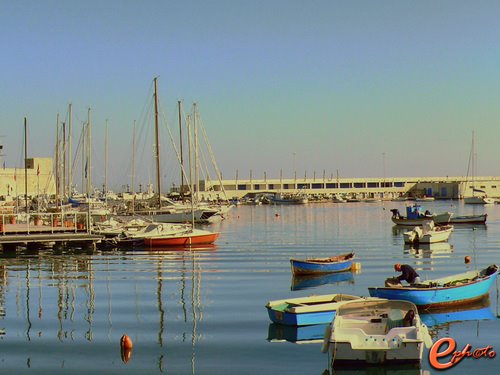Bari
From Wikipedia, the free encyclopedia
| Comune di Bari | |||
| |||
| Location of the city of Bari (red dot) within Italy. | |||
| Coordinates: | |||
| Region | Apulia | ||
|---|---|---|---|
| Province | Province of Bari | ||
| Founded | 1600 BC[1] | ||
| Government | |||
| - Mayor | Michele Emiliano | ||
| Area | |||
| - Total | 116 km² (44.8 sq mi) | ||
| Population (December 2005) | |||
| - Total | 328,458 (9th) | ||
| - Density | 2,827/km² (7,321.9/sq mi) | ||
| Time zone | CET (UTC+1) | ||
| - Summer (DST) | CEST (UTC+2) | ||
| Postal codes | 70100 | ||
| Area code(s) | 080 | ||
| Patron saints | San Nicola | ||
| Website: http://www.comune.bari.it | |||
Bari (Barium in Latin, from Greek Βάριον - Bàrion or Vàrion, Bare in Neapolitan) is the capital city of the province of Bari and of the Apulia (or, in Italian, Puglia) region, on the Adriatic sea, in Italy. It is the second economic centre of mainland Southern Italy and is well known as a port and university city, as well as the city of Saint Nicholas. The city itself has a decreasing population of 328,458 over 116 km², while the fast-growing urban area counts 653,028 inhabitants over 203 km². Another 500,000 people live in the metropolitan area.
Bari is made up of four different urban sections. To the north, the closely built old town on the peninsula between two modern harbours, with the splendid Basilica of Saint Nicholas, the Cathedral of San Sabino (1035 - 1171) and the Castello Svevo of Frederick II, is now also one of the major nightlife districts. The Murattiano section to the south, the modern heart of the city, is laid out on a rectangular gird-plan with a promenade on the sea, and the major shopping district (the via Sparano and via Argiro). The more modern city surrounding this center was the result of chaotic development during the 1960s and 1970s over the old suburbs that had developed along roads splaying outwards from gates in the city walls. Finally, the outer suburbs have been in rapid development during the 1990s. The city has a redeveloped airport named after Pope John Paul II, Karol Wojtyla Airport, with connections to several European cities.
Contents[hide] |
[edit] History
[edit] Ancient
Barion (Latin Barium), founded by the Greeks does not seem to have been a place of great importance in Greater Greece; only bronze coins struck by it have been found. Once it passed under Roman rule in the third century BC, it developed strategic significance as the point of junction between the coast road and the Via Traiana; a branch road to Tarentum led from Barium. Its harbour, mentioned as early as 181 BC, was probably the principal one of the district in ancient times, as it is at present, and was the centre of a fishery. The first historical Bishop of Bari was Gervasius who was noted at the Council of Sardica in 347. The bishops were dependent on the Patriarch of Constantinople until the 10th century.
[edit] Middle Ages
After the devastations of the Gothic Wars, under Lombard rule a set of written regulations was established, the Consuetudines Barenses, which influenced similar written constitutions in other southern cities.
For a brief period of 20 years, Bari was captured by Islamic invaders and became the Emirate of Bari under the emir Kalfun in 847. The city was soon reconquered by the Byzantines in 870. In 885, it became the residence of the local Byzantine catapan, or governor. The failed revolt (1009-1011) of the Lombard nobles Melus of Bari and his brother-in-law Dattus, against the Byzantine governorate, though it was firmly repressed at the Battle of Cannae (1018), offered their Norman adventurer allies a first foothold in the region. In 1025, under the Archbishop Byzantius, Bari became attached to the see of Rome and was granted "provincial" status.
In 1071, Bari was captured by Robert Guiscard, following a three-year siege. Maio of Bari (d. 1160), a Lombard merchant's son, was the third of the great admirals of Norman Sicily. The Basilica di San Nicola was founded in 1087 to receive the relics of this saint, which were surreptitiously brought from Myra in Lycia, in Byzantine territory. The saint began his development from Saint Nicolas of Myra into Saint Nicolas of Bari and began to attract pilgrims, whose encouragement and care became central to the economy of Bari. In 1095 Peter the Hermit preached the first crusade there. In October 1098, Urban II, who had consecrated the Basilica in 1089, convened the Council of Bari, one of a series of synods convoked with the intention of reconciling the Greeks and Latins on the question of the filioque clause in the Creed, which Anselm ably defended, seated at the pope's side. The Greeks were not brought over to the Latin way of thinking, and the Great Schism was inevitable.
A civil war broke out in Bari in 1117 with the murder of the archbishop, Riso. Control of Bari was seized by Grimoald Alferanites, a native Lombard, and he was elected lord in opposition to the Normans. By 1123, he had increased ties with Byzantium and Venice and taken the title gratia Dei et beati Nikolai barensis princeps. Grimoald increased the cult of St Nicholas in his city. He later did homage to Roger II of Sicily, but rebelled and was defeated in 1132.
Bari was occupied by Manuel I Komnenos between 1155-1158. In 1246, Bari was sacked and razed to the ground; Frederick II, Holy Roman Emperor and King of Sicily, repaired the fortress of Baris but it was subsequently destroyed several times. Bari recovered each time.
[edit] Early modern Bari
Isabella di Aragona, princess of Naples and widow of the Duke of Milan Gian Galeazzo Sforza, enlarged the castle, which she made her residence, 1499-1524. After the death of Bona Sforza, Queen of Poland, Bari came to be included in the Kingdom of Naples and its history contracted to a local one, as malaria became endemic in the region. Bari was wakened from its provincial somnolence by Napoleon's brother-in-law Joachim Murat. As Napoleonic King of Naples Murat ordered the building in 1808 of a new section of the city, laid out on a rational grid plan, which bears his name today as the Murattiano. Under this stimulus, Bari developed into the most important port city of the region. The legacy of Mussolini can be seen in the imposing architecture along the seafront.
[edit] The 1943 chemical warfare disaster
- Further information: Air Raid on Bari
Through a tragic coincidence intended by neither of the opposing sides in World War II, Bari gained the unwelcome distinction of being the only European city to experience chemical warfare in the course of that war.
On the night of December 2, 1943, German Junkers Ju 88 bombers attacked the port of Bari, which was a key supply center for Allied forces fighting their way up the Italian peninsula. Several Allied ships were sunk in the overcrowded harbor, including the U.S. Liberty ship John Harvey, which was carrying mustard gas; mustard gas was also reported to have been stacked on the quayside awaiting transport. The chemical agent was intended for use if German forces initiated chemical warfare. The presence of the gas was highly classified, and authorities ashore had no knowledge of it. This increased the number of fatalities, since physicians — who had no idea that they were dealing with the effects of mustard gas — prescribed treatment proper for those suffering from exposure and immersion, which proved fatal in many cases. Because rescuers were unaware they were dealing with gas casualties, many additional casualties were caused among the rescuers through contact with the contaminated skin and clothing of those more directly exposed to the gas.
On the orders of allied leaders Franklin D. Roosevelt, Winston Churchill and Dwight D. Eisenhower, records were destroyed and the whole affair was kept secret for many years after the war. The U.S. records of the attack were declassified in 1959, but the episode remained obscure until 1967. Indeed, even today, many "Baresi" are still unaware of what happened and why. Additionally, there is considerable dispute as to the number of fatalities. In one account: "[s]ixty-nine deaths were attributed in whole or in part to the mustard gas, most of them American merchant seamen" [2]; others put it as high as "more than one thousand Allied servicemen and more than one thousand Italian civilians." [3] Part of the confusion and controversy derives from the fact that the German attack, which became nicknamed "The Little Pearl Harbor", was highly destructive and lethal in itself, apart from the effects of the gas. Attribution of the causes of death to the gas, as distinct from the direct effects of the German attack, has proved far from easy.
The affair is the subject of two books: Disaster at Bari by Glenn B. Infield and Nightmare in Bari: The World War II Liberty Ship Poison Gas Disaster and Coverup by Gerald Reminick.
[edit] Bari today
Bari is now mostly a modern industrial city. Nevertheless, some of Italy's most interesting and undiscovered areas lie within the province of Bari, and the region of Puglia. Bari itself is a proud and hard-working port city with strong traditions based on its Saint Nicholas. Bari is known throughout Italy for its strong, often crude, spoken dialect, particularly in the Old Town, parts of which originated from a pidgin between Italian and Greek fishermen in the past, and which fishermen in Greece can still understand today.
[edit] Main sights
[edit] Basilica di San Nicola
The Basilica di San Nicola (Saint Nicholas) was founded in 1087 to receive the relics of this saint, which were brought from Myra in Lycia, and now lie beneath the altar in the crypt, where are buried the Topins, which are a legacy of old thieves converted to good faith. The church is one of the four Palatine churches of Apulia (the others being the cathedrals of Acquaviva delle Fonti and Altamura, and the church of Monte Sant'Angelo sul Gargano).
[edit] Cathedral of St. Sabinus
The church of St. Sabinus (the current Duomo of the city) was begun in Byzantine style in 1034, but was destroyed in the sack of the city of 1156. A new building was thus built between 1170-1178, partially inspired by that of San Nicola. Of the original edifice, only traces of the pavement are today visible in the transept.
An important example of Apulian Romanesque architecture, the church has a simple Romanesque façade with three portals; in the upper part is a rose window decorated with monstruous and fantasy figures. The interior has a nave and two aisles, divided by sixteen columns with arcades. The crypt houses the relics of St. Sabinus and the icon of the Madonna Odigitria.
The interior and the façade were redecorated in Baroque style during the 18th century, but these additions were deleted in the 1950s restoration.
[edit] Petruzzelli Theatre
Fire-bombed in the early 1990s, the Petruzzelli theatre had been one of the grandest opera houses in Italy after La Scala in Milan and the San Carlo Theatre in Naples. Host to many famous opera and ballet greats throughout the last century, the shell of the Petruzzelli in Corso Cavour is subject to an ongoing restructuing project. Although seemingly slow, the theatre should re-open its doors before 2010
[edit] Castello Normanno Svevo
The Norman-Hohenstaufen Castle, widely known as the Castello Svevo, was built by Roger II of Sicily around 1131. Destroyed in 1156, it was rebuilt by Frederick II of Hohenstaufen. The castle now serves as a gallery for a variety of temporary exhibitions in the city.
[edit] The Russian Church
The Russian Church, in the Carrassi district of Bari was built in the early 20th century to welcome Russian pilgrims who came to the city to visit the church of Saint Nichlas in the old city where the relics of the saint remain.
Built on a large area of council-owned land, the city council and Italian national government were recently involved in a trade-off with the Putin government in Moscow, exchanging the piece of land on which the church stands, for, albeit indirectly, a military barracks near Bari's central station. The hand over was seen as building bridges between the Catholic and Russian Orthodox churches.
[edit] Barivecchia
Barivecchia, or Old Bari, is a sprawl of streets and passageways making up the section of the city to the North of the modern Murat area. Barivecchia was until fairly recently considered a no-go area by many of Bari's residents due to the high levels of petty crime. A large-scale redevelopment plan beginning with a new sewerage system and followed by the development of the two main squares, Piazza Mercantile and Piazza Ferrarese has seen the opening of many pubs and other venues. This has been welcomed by many who claim that the social life of the city, and in particular the experience for tourists in Bari, has been improved and that jobs and revenue have been created. Others point out the effects of late-night noise in the enclosed squares and criticise development based mainly on pubs and other such premises.
[edit] Other
- Teatro Margherita.
- Teatro Piccinni.
- Orto Botanico dell'Università di Bari, a botanical garden.
- Santa Chiara, once church of the Teutonic Knights (as Santa maria degli Alemanni) and now closed. It was restored in 1539.
- The medieval church of San Marco dei Veneziani, with a notable rose window in the façade.
- San Giorgio degli Armeni.
- Santa Teresa dei Maschi, the main Baroque church in the city (1690-1696).
- Pane e Pomodoro Beach is the main beach within reach of the city. Its reputation has for several years suffered from the apparent presence of asbestos from nearby industrial plants.
- The eastern seafront skyline of Bari had, until spring 2006, been dominated by the monsterous apartment complex known as Punta Perotti - a creation of the Matarrese construction empire. Clearly in violation of several fundamental Italian building regulations, Punta Perotti became the focus of a political and environmental movement calling for its demolition. After years of legal wrangling between the Matarrese firm, Bari Council and environmental groups such as Save the Earth, the court ruled in favour of its demolition and thousands gathered on the Bari seafront in April 2006 to see the event.
- The grid-shaped Murat city Centre of Bari is said to be the largest shopping centre in all of Italy and contains a large number of high-street stores and smaller shops with particular attention to high fashion and tailoring. Bari has recently seen a proliferation of out of town hypermarkets with all manner of shops and superstores attached to them.
[edit] Geography
[edit] Quarters
| Municipality | Quarters |
|---|---|
| I | Palese Macchie & Santo Spirito-Catino-San Pio |
| II | San Paolo & Stanic |
| III | Picone & Poggiofranco |
| IV | Carbonara-Santa Rita, Ceglie del Campo & Loseto |
| V | Japigia, Torre a Mare & San Giorgio |
| VI | Carrassi, San Pasquale & Mungivacca |
| VII | Madonnella |
| VIII | Libertà & Marconi-San Girolamo-Fesca |
| IX | Murat & San Nicola |
Shown above are the twenty quarters of Bari: these twenty neighbourhoods or "quartiere" as they are known, are further divided into nine governmental community boards.[4]
[edit] Fiera del Levante
The Fiera del Levante is said to be the largest trade fair in the Adriatic and involves exhibitions from many sectors and industries. Held in September in the Fiera site on the west side of Bari city centre, the Fiera attracts many exhibitors from Italy, around the Mediterranean, its trade corridors to the east and beyond. Mainly focused on agriculture and industry, there are also stalls, exhibitions and presentations by a wide variety of compaines and organisations in many fields. There is also a "Fair of Nations" which displays handcrafted and locally produced goods from all over the world.
This year's Fiera also saw an "Expo Fishing" which brought together fishing methods, tackle and know-how from across the Mediterranean.
[edit] Culinary Bari
Bari's cuisine, one of Italy's most traditional and noteworthy is based on three typical agricultural products found within the surrounding Puglia region, namely wheat, olive oil and wine. Bari cuisine is also enriched by the wide variety of fruit and vegetables produced locally. Local flour is used in homemade bread and pasta production including, most notably, the famous orecchiette hat-shaped pasta, recchietelle or strascinate, chiancarelle (orecchiette of different sizes) and cavatelli.
Homemade dough is also used for baked calzoni stuffed with onions, anchovies, capers and olives; fried panzerotti with mozzarella, simple focaccia alla barese with tomatoes, little savoury taralli, friselle and sgagliozzi, fried slices of polenta all make up the Bari culinary reportoire.
Olive oil and garlic are widely in use. Vegetable minestrone, chick peas, broad beans, chickory, celery and fennel are also often served as first courses or side dishes.
Meat dishes include lamb, pork and often horse meat, considered something of a local delicacy.
Bari, being the capital of an important fishing region, offers a range of fresh fish and seafood, often eaten raw. Octopus, sea urchins and mussels feature heavily. Indeed, perhaps Bari's most famous dish is the oven-baked Riso, patate e cozze (Rice, Potatoes and Mussels)
Bari and its province, not to mention the Puglia region has a range of notable wines including Primitivo, Castel del Monte and Moscato di Trani amongst them.
[edit] Administrative divisions
Bari is separated into nine administrative divisions.
- I - Palese Macchie, Santo Spirito, Catino, San Pio
- II - San Paolo, Stanic
- III - Picone, Poggiofranco
- IV - Carbonara, Santa Rita, Ceglie del Campo, Loseto
- V - Japigia, Torre a Mare, San Giorgio
- VI - Carrassi, San Pasquale, Mungivacca
- VII - Madonnella
- VIII - Libertà, Marconi, San Girolamo, Fesca
- IX - Murat, San Nicola
[edit] Sport
Local football club A.S. Bari, currently competing in Serie B, plays in the impressive Stadio San Nicola, an architecturally innovative 58,000-seater stadium purpose-built for the 1990 FIFA World Cup. The stadium also hosted the 1991 European Cup Final.
[edit] Demographics
In 2007, there were 325,052 people residing in Bari (in which slightly 1.6 million live in the greater Bari area), located in the province of Bari, Puglia, of whom 48.1% were male and 51.9% were female. Minors (children ages 18 and younger) totalled 17.90 percent of the population compared to pensioners who number 19.08 percent. This compares with the Italian average of 18.06 percent (minors) and 19.94 percent (pensioners). The average age of Bari resident is 42 compared to the Italian average of 42. In the five years between 2002 and 2007, the population of Bari grew by 2.69 percent, while Italy as a whole grew by 3.56 percent.[1][2] The current birth rate of Bari is 8.67 births per 1,000 inhabitants compared to the Italian average of 9.45 births.
As of 2006, 98.34% of the population was of Italian descent. The largest immigrant group came from other European nations (particularly those from Albania and Greece): 0.68%, and East Africa: 0.42%. Immigrants from North Africa, and East Asia make up an even smaller number portion of the population.
[edit] People Associated with Bari
[edit] Twin towns
 Batumi, Georgia
Batumi, Georgia Guangzhou, People's Republic of China
Guangzhou, People's Republic of China Mar del Plata, Argentina
Mar del Plata, Argentina Durrës, Albania
Durrës, Albania Corfu, Greece
Corfu, Greece Banja Luka, Bosnia and Herzegovina
Banja Luka, Bosnia and Herzegovina Patras, Greece
Patras, Greece
[edit] See also
- Antivari (means 'opposite Bari')
- Bari International Airport
- Province of Bari
- Basilica di San Nicola (Bari)
- Polytechnic University of Bari
- University of Bari
[edit] References
- This article incorporates text from the Encyclopædia Britannica Eleventh Edition, a publication now in the public domain.
[edit] Further reading
- Vito Antonio Melchiorre, Note storiche su Bari 2001.
[edit] External links
- City of Bari
- Province of Bari
- Region of Apulia
- Bari Karol Wojtyla Airport
- University of Bari
- Polytechnic of Bari
- Niccolò Piccinni Music Conservatory
- AS Bari Football Club
- AMTAB - Urban Transport company
- Petruzzelli and Theaters of Bari Lyrical Symphonic Foundation
- Teatro Pubblico Pugliese (Apulian Public Theater)
- Fiera del Levante Exhibition Centre
- Worldfacts: "Bari, Italy"
- Catholic Encyclopedia; "Bari"
| ||||
| ||

